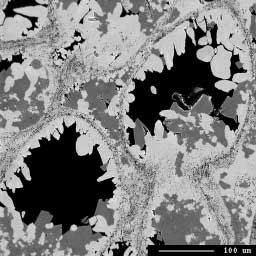|
|
 |
|
|
 |
Another area of active research involves investigating biogeochemical reactions in clastic settings by integrating the geochemistry of interstitial waters and authigenic carbonates recovered from the New Jersey slope and shelf (Leg 174A) and from the South Tasman margin (Leg 189). Active paleoceanographic studies include (1) using bulk and fine fraction elemental and isotopic composition to unravel diagenetic versus secular variability in little altered pelagic carbonate sediments from Shatsky Rise in the Pacific (ODP Leg 198) and (2) using pore water oxygen isotopic composition and a numerical model to extract the change in Southern Ocean bottom water oxygen isotopic composition since the last glacial maximum.
A new research endeavor focuses on understanding the origin of a subsurface brine on Demerara Rise, offshore Suriname (Leg 207). I will also be investigating the origin of diagenetic carbonates within the Cretecous black shales of Demerara Rise, which also appear to be acting as an aquifer for the brine.
Malone, M.J., Martin, J.B., Schoenfeld, J. Ninnemann, U.S., Nuernberg, D., and White, T.S. (submitted) The oxygen isotopic composition and temperature of Southern Ocean bottom waters during the last glacial maximum. Earth and Planetary Science Letters, in review.
Erbacher, J., Mosher, D., Malone, M.J. and the Leg 207 Science Party (in review) Drilling uncovers causes and consequences of carbon cycle perturbations during the Cretaceous to Paleogene greenhouse. EOS, in review
Malone, M.J., Claypool, G., Martin, J.B., and Dickens, G.R., (2002). Variable methane fluxes in shallow marine systems over geologic time: the composition of pore waters and authigenic carbonates on the New Jersey shelf. Marine Geology, 189:173-194.
Bralower, T., Premoli Silva, I., Malone, M.J., and the Leg 198 Science Party (2002) New evidence for ancient global warmth in the Cretaceous and Paleogene: an Ocean Drilling Program expedition to Shatsky Rise, northwest Pacific (cover article). GSA Today, 12:4-10.
Exon, N.F., Kennett, J.P., Malone, M.J., and the Leg 189 Shipboard Party (2002) Drilling reveals climatic consequences of Tasmanian Gateway opening (cover article). EOS, 83, no. 23:253, 258.
Mitterer, R.M., Malone, M.J. Goodfriend, G.A., Swart, P.K., Wortmann, U., Logan, G.A., Feary, D.A., and Hine, A.C. (2001) Co-generation of hydrogen sulfide and methane in marine carbonate sediments. Geophysical Research Letters, 28: 3931-3934.
Malone, M.J., Slowey, N.C., and Henderson, G.M. (2001) Early diagenesis of shallow-water, periplatform carbonate sediments, leeward margin, western Great Bahama Bank (ODP Leg 166). GSA Bulletin, 113: 881-894.
Swart, P.K., Wortmann, U.G., Mitterer, R.M., Malone, M.J., Smart, P.L., Feary, D., Hine, A.C., and Shipboard Scientific Party (2000). Hydrogen sulfide-rich hydrates and saline fluids in the continental margin of south Australia. Geology, 28: 1039-1042.
James, N.P., Feary, D.A., Surlyk, F., Simo, J.A., Betzler, C., Holbourn, A.E., Li, Q., Matsuda, H., Machiyama, H., Brooks, G.R., Andres, M., Hine, A.C., Malone, M.J., and the ODP Leg 182 Scientific Party (2000) Quaternary bryozoan reef-mounds in cool water, upper slope environments, Great Australian Bight, Geology, 28: 647-650. Hine, A.C, Feary, D.A., Malone, M.J., and the Leg 182 Shipboard Party (1999) Research in Great Australian Bight yields exciting early results (cover article). EOS, 80, no. 44, p. 521, 525-526. Malone, M. and Baker, P. (1999) Temperature dependence of the strontium distribution coefficient in calcite: an experimental study from 40° to 200° C and application to natural diagenetic calcites. Journal of Sedimentary Research, v. 69: 228-235.
Malone, M. Baker, P. and Burns, S. (1996) Recrystallization of dolomite: an experimental study from 50° to 200° C: Geochimica et Cosmochimica Acta, v. 60: 1289-2207.
Malone, M. Baker, P. and Burns, S. (1996) Hydrothermal dolomitization and recrystallization of dolomite breccias from the Miocene Monterey Formation, Tepusquet Area, California: Journal of Sedimentary Research
Malone, M. Baker, P. and Burns, S. (1994) Recrystallization of dolomite: evidence from the Monterey Formation (Miocene), California: Sedimentology, v. 41: 1223-1239.